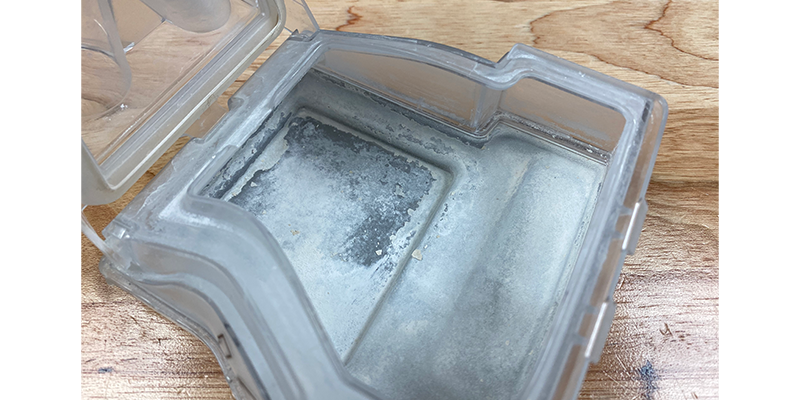
Use only distilled water to avoid buildup of mineral residue like this.
When CPAP devices come to us for repair, we see humidifier water chambers at their best and at their worst. Humidifier chambers that haven’t been cared for properly can breed bacteria or mold that’s entering your airway every night, and they can also become cracked, cloudy or so filled with mineral residue – as a result of using tap water – that replacement is your only option.
The good news is that water chambers are intended to be replaced regularly, so be sure you are following the manufacturer recommendations for replacement. ResMed, for instance, recommends replacement of your humidifier water chamber every six months, and if you have a current CPAP prescription your insurance company may pay for it. Check with your home medical equipment provider or insurance company to see if your resupplies are covered.
In addition to regular replacement, taking good care of your water chamber should be a daily part of your life with CPAP therapy. Here are a few tips:
- Clean it properly. After detaching the chamber from your device, clean it daily with mild soap and warm, drinking-quality water. Avoid cleaning products such as dish detergent, alcohol, bleach, chlorine or moisturizing or antibacterial soaps. After cleaning, rinse it thoroughly using warm, drinking-quality water, then place it on a flat surface on a towel to dry. Weekly, soak the chamber in a solution of one-part white vinegar and one-part water for 15-20 minutes. Then rinse thoroughly with warm, drinking-quality water and place it on a towel on a flat surface to dry. Here are more cleaning tips from ResMed.
- Use distilled water. Always fill your chamber with distilled water at room temperature. Tap water can leave behind residue and bacteria. Do not use hot water, and never add any kind of scented oils or aromatherapy.
- Never let water get into your device. Take care to never fill your chamber past the maximum water level mark, and make sure that your chamber is empty and dry before you transport your device. If water gets into your CPAP, it can cause corrosion or other damage to the electrical components.
But your water chamber and CPAP accessories aren’t the only things that might be ready for a cleaning. Mold, bacteria and mineral residue can get inside the CPAP device itself. That’s why we recommend an annual CPAP Checkup, which gives your device a deep internal and external cleaning, new seals and filters, an update to your firmware and a diagnostic check to be sure it’s operating properly. To learn more about our CPAP Checkup service, click here.
